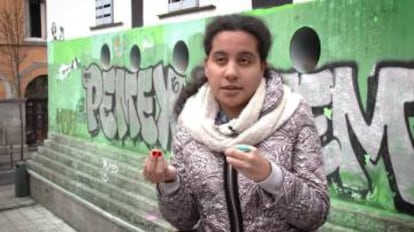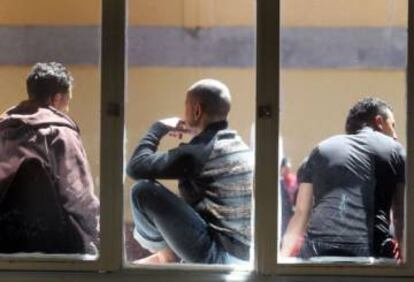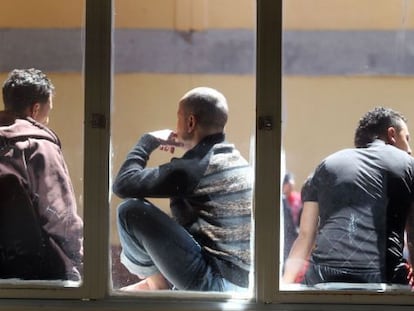Why thousands of migrants are being locked up in Spain for nothing
Two out of three foreigners who spent time at detention centers in 2016 were ultimately released
Inside, Prakash was not Prakash. ¡°22-13. Those are the numbers they used to call me through the loudspeaker system. That was my name in there,¡± says this 33-year-old from Nepal, sipping on a Coke as he recalls the 58 days he spent inside an immigrant detention center in Aluche (Madrid).

¡°I was arrested on November 28, 2014. I was walking toward the industrial park in [Madrid municipality] Parla where I worked. I remember it was rainy that day; when I crossed the highway, some plainclothes officers stopped me and asked me for my papers,¡± he says.
It was the beginning of two months of detention, ¡°fear¡± and ¡°suffering¡± for nothing: eventually, he was released. Same as with 71% of the 7,597 migrants who spent time at these facilities in 2016, according to Interior Minister figures that El PA?S has had access to.
I hadn¡¯t committed any crime. And when I got out, I had lost my job
Prakash, Nepali citizen
Two years later, Prakash, who is married and has a months-old baby now, says that he was unlucky that day. ¡°What if I had crossed at that spot just one hour earlier?¡± he wonders. ¡°I might not have been locked up.¡±
By contrast, around 100 undocumented migrants were found hanging around the bus station of Motril (Granada) in October of last year, after reaching Spain by raft. The police arrested them, but 72 hours later they walked free because all the centers, known by their Spanish acronym of CIE, were full. And that was that.
One month before, a group of 45 migrants who landed on the Mediterranean island of Tabarca, near Alicante, ended up at the Barcelona CIE.
Non-profit groups point out these examples to illustrate the ¡°arbitrariness¡± that pervades a system dragged down by automated police and judicial procedures.
Goal unmet
The CIEs (which stand for Centro de Internamiento de Extranjeros, or Foreigner Internment Center), were created in 1985 in order to ¡°detain and hold in custody¡± illegal aliens and ¡°guarantee their deportation.¡± There are currently seven in operation throughout the country, and the maximum legal detention time is 60 days.

But Interior Ministry data reveal how this goal is not being met: far from it, the system underperforms more with every passing year. In 2009, 70% of interns were deported; in 2013 that figure had dropped to 52%, in 2015 it slipped further to 41% and last year it stood at 29%.
That is why non-profit groups say that these centers have become an ¡°abusive¡± tool to hold immigrants even though authorities often know that their removal will not be possible.
¡°For instance, the Barranco Seco center [in Las Palmas de Gran Canaria] is being used as a distribution center; migrants who arrive at the islands are put in there until a decision is made regarding what to do with them,¡± says Andr¨¦s Garc¨ªa Berrio, a lawyer for a group campaigning to shut down the CIEs, Campa?a Estatal para el cierre de los CIE.
Barranco Seco only sends back 0.6% of interns. This rate rises to 12% in Tenerife, 15% in Algeciras and 21.4% in Barcelona, according to government figures. Madrid, Murcia and Valencia have higher-than-average rates at 46%, 58% and 59% respectively.
Mostly Africans
Several automated procedures, such as immediately holding all immigrants who arrive by sea, have turned the CIEs into veritable prisons for Africans. According to Interior Ministry figures seen by EL PA?S, 89.9% of interns last year came from Africa, compared with 4.3% from the Americas, 3.3% from Europe and 2.5% from Asia.
If less than half of interns are being deported, what part of the process is malfunctioning?
¡°Besides, ethnic profiling is still a reality in Spain. We have clearly detected that many of the people locked up in there were stopped on the street because of their skin color,¡± says Carmen Echevarria, of Karibu, a support group for Africans held at the Madrid CIE.
Although Spanish legislation clearly stipulates that CIEs lack a ¡°penitentiary nature,¡± in practice they function as prisons. Some, in fact, are housed in former prisons, such as the Algeciras center.
Not enough control
So if fewer than half of interns are being deported. what part of the process is malfunctioning?
In 2014, an internal memo sent out by National Police headquarters admitted that there was ¡°a considerable number of internment requests, even though the situation does not always make it recommendable to adopt such a measure.¡±

The police memo insisted that, before asking for a migrant¡¯s internment, officers should carefully analyze their personal situation, whether they have children in their care, the consequences of deportation for the family, and the real chances of removal taking place.
According to figures from the Attorney General¡¯s Office, judges and prosecutors only stop around 20% of internment requests against migrants filed by police officers.
A report by the Jesuit Migrant Center (SJM) shows that 58% of interns in 2015 had arrived by sea on rafts and taken straight to the centers. Another 36% were arrested on the street. ¡°Only 7% are in there with deportation orders issued by a judge,¡± notes the report.
EL PA?S asked the Interior Ministry for figures regarding the reasons for internment, but received no reply. Authorities do not allow the media into the CIEs, and even non-profit groups have limited access.
Underage migrants
Agrippine (an assumed name), 16, arrived at the coast of Andalusia after a sea journey on a raft. The SJM report says that authorities detected she had been a victim of human trafficking, yet a judge ordered her into a CIE in a decision affecting an entire group of migrants.
Non-profit groups say that these centers have become an ¡°abusive¡± tool
¡°We have seen orders deciding on the internment of up to 50 people at a time, with no individualization of each case,¡± says another SJM report.
EL PA?S has seen one of those orders, signed by a Motril judge in December 2015. The 39 migrants who were ordered into a CIE were represented by a single state-appointed attorney at the hearing.
¡°These resolutions make a mockery of the right to a defense,¡± says Margarita Mart¨ªnez Escamilla, a professor of criminal law at Madrid¡¯s Complutense University.
As a result of these shortcomings, human trafficking victims, minors and asylum seekers have all ended up at these centers. As have hundreds of other migrants who were finally released without deportation orders.
Punishment
The CIEs hold both individuals with criminal records and those without. And the second group is larger. Although the Interior Ministry likes to point out that half of interns have a rap sheet, a report by four Spanish universities notes that, to the ministry, simply having a deportation order issued against you automatically means you have a criminal record.
¡°In the end, these centers are being used to send out a message to those who come: it¡¯s a warning that we are not going to be so welcoming,¡± says the lawyer Garc¨ªa Berrio. ¡°People inside the CIEs have the feeling that they are there out of bad luck: someone was in the wrong place, at the wrong time.¡±
Prakash, the citizen from Nepal, was arrested in November 2014, after living in Spain for nearly three years. He was released again in January 2015. ¡°I hadn¡¯t committed any crime. And when I got out, I had lost my job and it took me nearly 10 months to find another one,¡± he explains. ¡°We lived off whatever my wife made cleaning homes.¡±
English version by Susana Urra.
Tu suscripci¨®n se est¨¢ usando en otro dispositivo
?Quieres a?adir otro usuario a tu suscripci¨®n?
Si contin¨²as leyendo en este dispositivo, no se podr¨¢ leer en el otro.
FlechaTu suscripci¨®n se est¨¢ usando en otro dispositivo y solo puedes acceder a EL PA?S desde un dispositivo a la vez.
Si quieres compartir tu cuenta, cambia tu suscripci¨®n a la modalidad Premium, as¨ª podr¨¢s a?adir otro usuario. Cada uno acceder¨¢ con su propia cuenta de email, lo que os permitir¨¢ personalizar vuestra experiencia en EL PA?S.
?Tienes una suscripci¨®n de empresa? Accede aqu¨ª para contratar m¨¢s cuentas.
En el caso de no saber qui¨¦n est¨¢ usando tu cuenta, te recomendamos cambiar tu contrase?a aqu¨ª.
Si decides continuar compartiendo tu cuenta, este mensaje se mostrar¨¢ en tu dispositivo y en el de la otra persona que est¨¢ usando tu cuenta de forma indefinida, afectando a tu experiencia de lectura. Puedes consultar aqu¨ª los t¨¦rminos y condiciones de la suscripci¨®n digital.










































